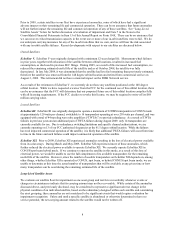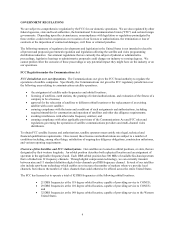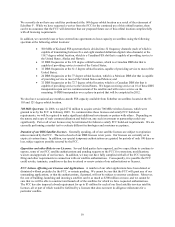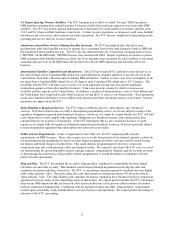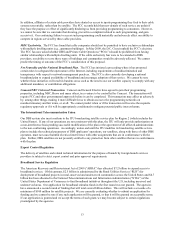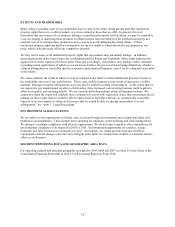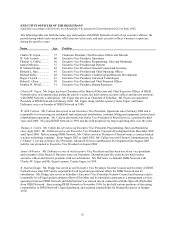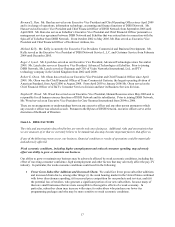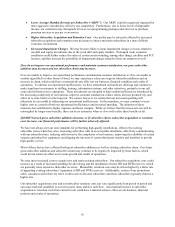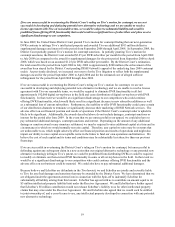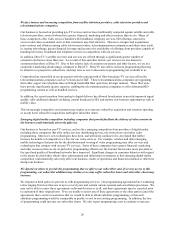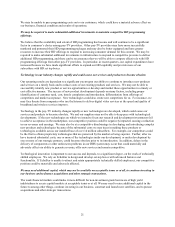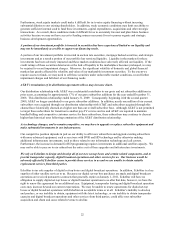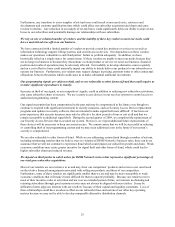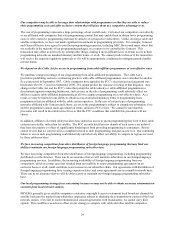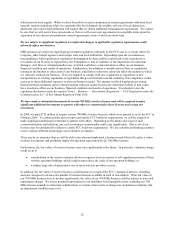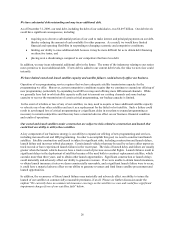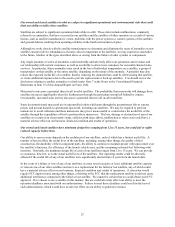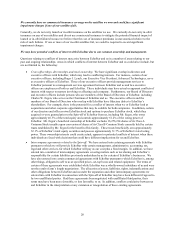Dish Network 2009 Annual Report Download - page 28
Download and view the complete annual report
Please find page 28 of the 2009 Dish Network annual report below. You can navigate through the pages in the report by either clicking on the pages listed below, or by using the keyword search tool below to find specific information within the annual report. 18
x Lower Average Monthly Revenue per Subscriber (“ARPU”). Our ARPU could be negatively impacted by
more aggressive introductory offers by our competitors. Furthermore, due to lower levels of disposable
income, our customers may downgrade to lower cost programming packages and elect not to purchase
premium services or pay per view movies.
x Higher Subscriber Acquisition and Retention Costs. Our profits may be adversely affected by increased
subscriber acquisition and retention costs necessary to attract and retain subscribers in a more difficult
economic environment.
x Increased Impairment Charges. We may be more likely to incur impairment charges or losses related to
our debt and equity investments due to the weak debt and equity markets. Prolonged weak economic
conditions could further reduce the value of certain assets including, among other things, satellites and FCC
licenses, and thus increase the possibility of impairment charges related to these investments as well.
If we do not improve our operational performance and maintain customer satisfaction, our gross subscriber
additions may decrease and our subscriber churn may increase.
If we are unable to improve our operational performance and maintain customer satisfaction or if we are unable to
combat signal theft or other forms of fraud, we may experience a decrease in gross subscriber additions and an
increase in churn, which could have a material adverse effect on our business, financial condition and results of
operations. To address our operational inefficiencies, we have streamlined our hardware offerings and continue to
make significant investments in staffing, training, information systems, and other initiatives, primarily in our call
center and in-home service operations. These investments are intended to help combat inefficiencies introduced by
the increasing complexity of our business, improve customer satisfaction, reduce churn, increase productivity, and
allow us to scale better over the long run. We cannot, however, be certain that our increased spending will
ultimately be successful in addressing our operational inefficiencies. In the meantime, we may continue to incur
higher costs as a result of both our operational inefficiencies and increased spending. The adoption of these
measures has contributed to higher expenses and lower margins. While we believe that the increased costs will be
outweighed by longer-term benefits, there can be no assurance when or if we will realize these benefits at all.
If DISH Network gross subscriber additions decrease, or if subscriber churn, subscriber acquisition or retention
costs increase, our financial performance will be further adversely affected.
We have not always met our own standards for performing high-quality installations, effectively resolving
subscriber issues when they arise, answering subscriber calls in an acceptable timeframe, effectively communicating
with our subscriber base, reducing calls driven by the complexity of our business, improving the reliability of certain
systems and subscriber equipment, and aligning the interests of certain third party retailers and installers to provide
high-quality service.
Most of these factors have affected both gross subscriber additions as well as existing subscriber churn. Our future
gross subscriber additions and subscriber churn may continue to be negatively impacted by these factors, which
could in turn adversely affect our revenue growth and results of operations.
We may incur increased costs to acquire new and retain existing subscribers. Our subscriber acquisition costs could
increase as a result of increased spending for advertising and the installation of more HD and DVR receivers, which
are generally more expensive than other receivers. Meanwhile, retention costs may be driven higher by a faster rate
of upgrading existing subscribers’ equipment to HD and DVR receivers. Additionally, certain of our promotions
allow consumers with relatively lower credit scores to become subscribers and these subscribers typically churn at a
higher rate.
Our subscriber acquisition costs and our subscriber retention costs can vary significantly from period to period and
can cause material variability to our net income (loss) and free cash flow. Any material increase in subscriber
acquisition or retention costs from current levels could have a material adverse effect on our business, financial
position and results of operations.


